| FAQ |
| Members List |
| Social Groups |
| Calendar |
| Search |
| Today's Posts |
|
#21
|
||||
|
||||
|
You'll need a bigger chimney.
__________________
My Pontiac is a '57 GMC with its original 347" Pontiac V8 and dual-range Hydra-Matic. |
|
#22
|
||||
|
||||
|
So what's the consensus on the reliability and parts availability (slim to none is my guess) for the Hydra-Matic trans?
Did they have a good reputation back in their day? Good core for a '59 Pontiac owner? Boat anchor? 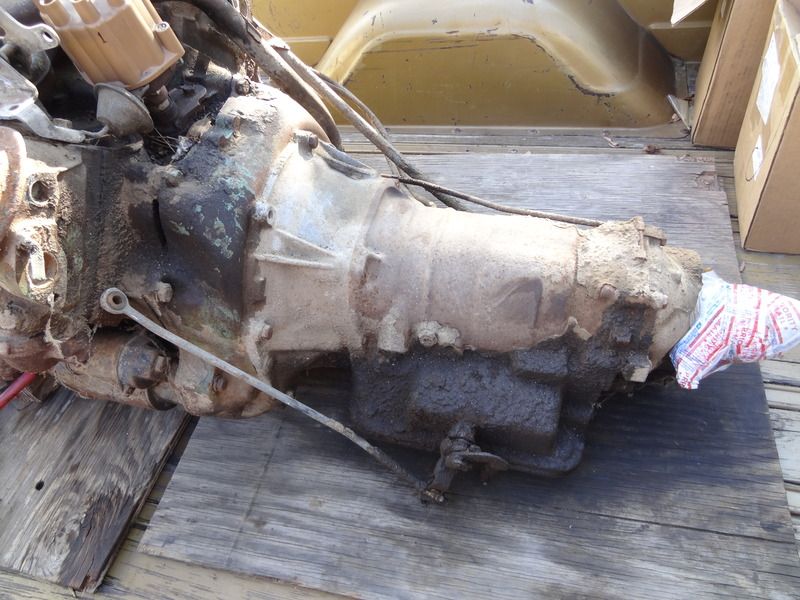
__________________
1964 Tempest Coupe LS3/4L70E/3.42 1964 Le Mans Convertible 421 HO/TH350/2.56 2002 WS6 Convertible LS1/4L60E/3.23 |
|
#23
|
||||
|
||||
|
Pretty sure parts are available, you can hunt Hemming's, or call Egge.
http://egge.com/ There's a couple other vendors that specialize in pre-'64 cars too, can shop them, like Kanter. Edit: Here you go: http://www.autotran.us/#P .
__________________
. 1970 GTO Judge Tribute Pro-Tour Project 535 IA2 http://forums.maxperformanceinc.com/...d.php?t=760624 1971 Trans Am 463, 315cfm E-head Sniper XFlow EFI, TKO600 extreme, 9", GW suspension, Baer brakes, pro tour car https://forums.maxperformanceinc.com...ght=procharger Theme Song: http://www.youtube.com/watch?v=7zKAS...ature=youtu.be |
|
#24
|
||||
|
||||
|
Quote:
BR's, Mark |
|
#25
|
||||
|
||||
|
I've talked to a few 50's Pontiac guys and that transmission was decently reliable in moving these cars compared to the Slim Jim and others. It wasn't a powerhouse and weighs a ton. Biggest concern is like anything else in the pre-TH350\400 days is finding anyone who knows how to make them work if there's something wrong with it. I'm sure a smart and dedicated person with the factory service book and right tools could make it happen though.
|
|
#26
|
|||
|
|||
|
These dual coupling 4 speeds are fantastic if you can find someone to rebuild it that really knows 'em well. Make sure they take a good look at the coupling cover for cracks. That pretty much their only weak point.
First gear is a monster low 3.97. Even the 2.55 second gear is steeper than 1st in most 3 speed autos. The transmission is "locked up" once in second gear and uses a unique split torque design that's incredibly efficient. Believe it or not, dual band/dual couplings were the most efficient automatic transmissions around until lockup torque converter trannys became common in the 1980's. |
|
#27
|
||||
|
||||
|
nice find. The rear plugs are looking at me. LOL
__________________
67 Firebird Convertible |
|
#28
|
||||
|
||||
|
The 1959 Pontiac along with the new big-cube 389 ushered in the true beginning of Pontiac street performance and the start of the wide-track era.
Pontiacs pretty much ruled the streets starting in '59, the 389 was the bread and butter standard offering up through '66 and provided plenty of power. Now looking to scrape up a '59 Tri-Power intake for this future project. Old is gold.
__________________
1964 Tempest Coupe LS3/4L70E/3.42 1964 Le Mans Convertible 421 HO/TH350/2.56 2002 WS6 Convertible LS1/4L60E/3.23 |
|
#29
|
|||
|
|||
|
if you swap to a th400, how do you plan to run a starter?
|
|
#30
|
||||
|
||||
|
__________________
1964 Tempest Coupe LS3/4L70E/3.42 1964 Le Mans Convertible 421 HO/TH350/2.56 2002 WS6 Convertible LS1/4L60E/3.23 |
|
#31
|
||||
|
||||
|
Looks like it's smiling at you! LOL!
__________________
Paul Carter Carter Cryogenics www.cartercryo.com 520-409-7236 Koerner Racing Engines You killed it, We build it! 520-294-5758 64 GTO, under re-construction, 412 CID, also under construction. 87 S-10 Pickup, 321,000 miles 99Monte Carlo, 293,000 miles 86 Bronco, 218,000 miles |
|
#32
|
||||
|
||||
|
....to get the 389 ready for storage. I did as much cleaning as I could muster before calling it good enough for now.
After a half-hearted effort at trying to separate the engine from the trans I stopped for the day. I only got as far as removing the six nuts from the flex plate to the fluid coupling through the starter hole (bottom picture), but I really don't know how to go about finishing the deed. Any tips or words of wisdom on how to separate the two would be appreciated, I'm in uncharted waters here. 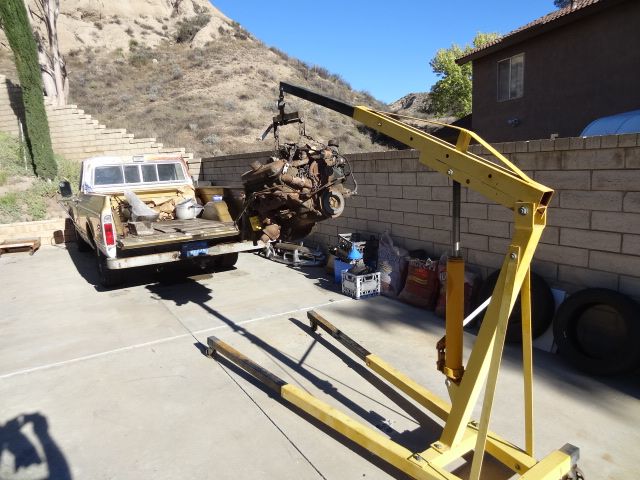 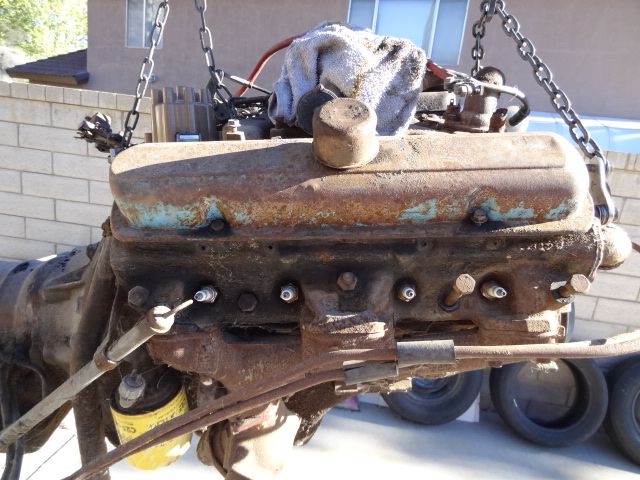 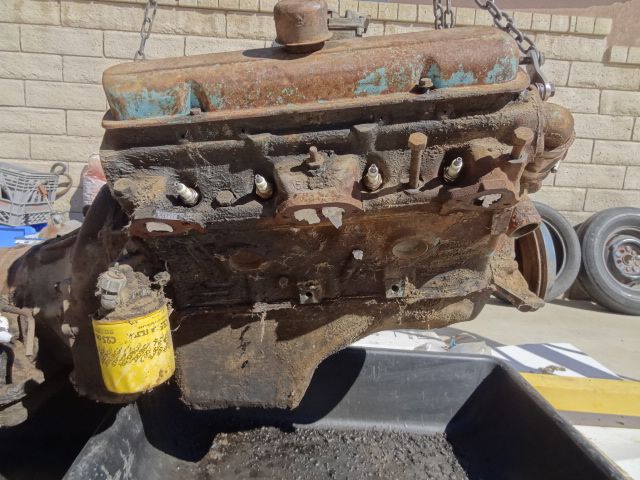  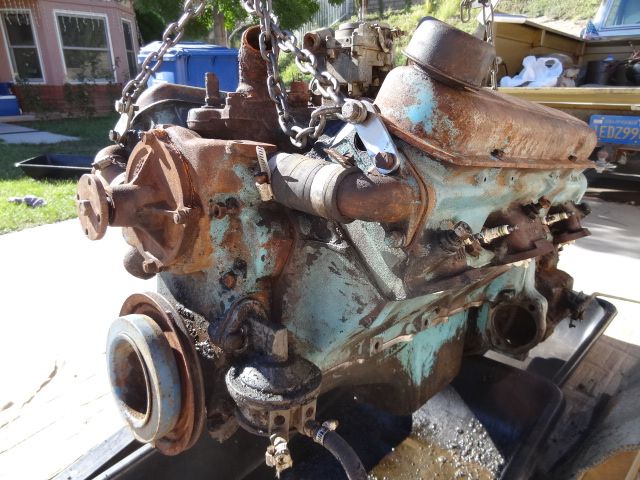 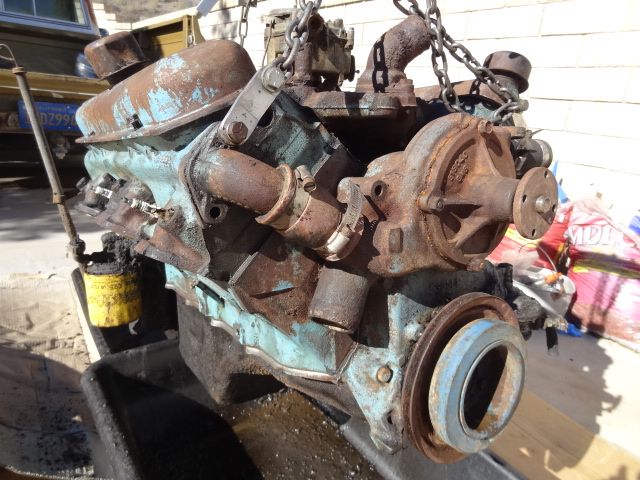 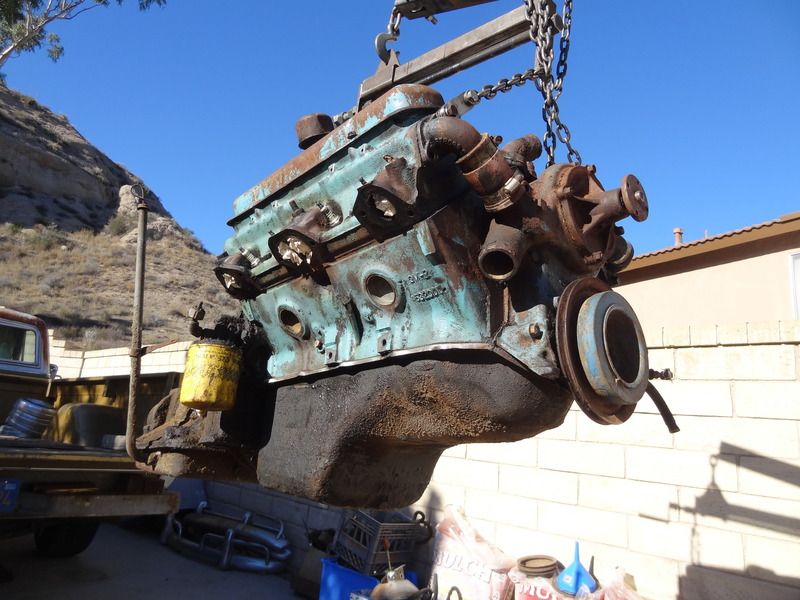 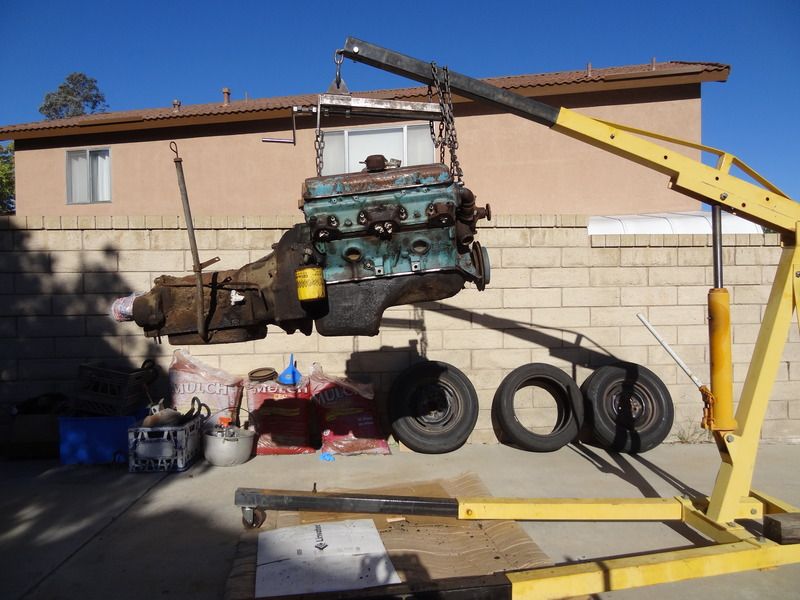 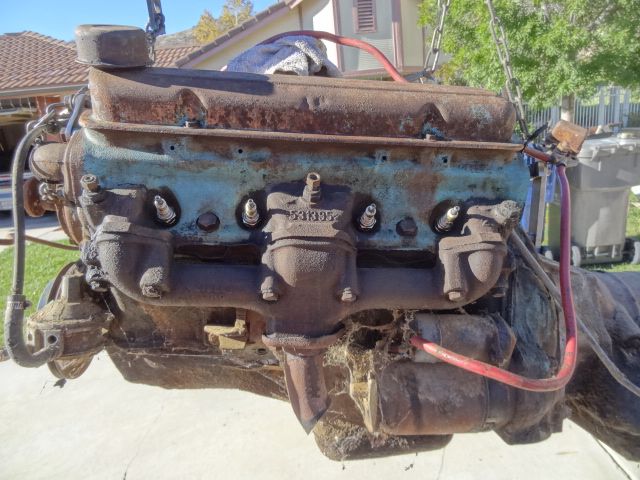  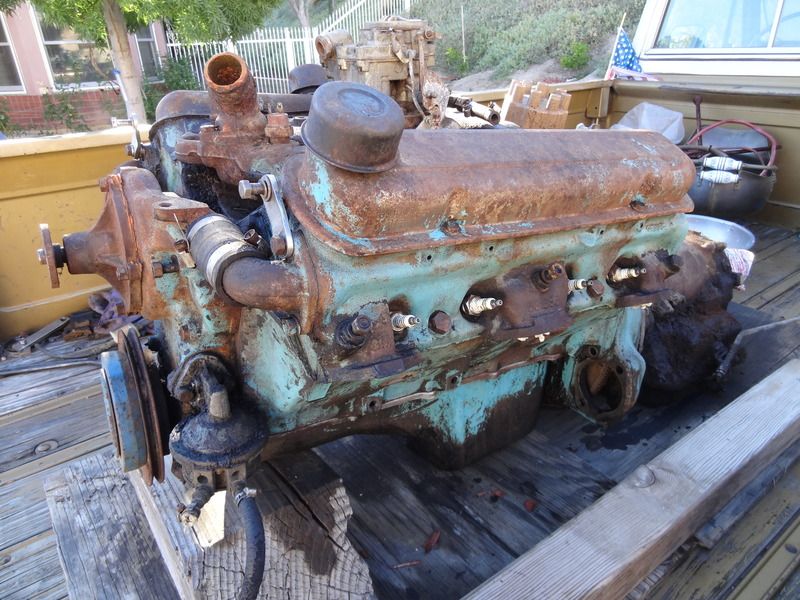 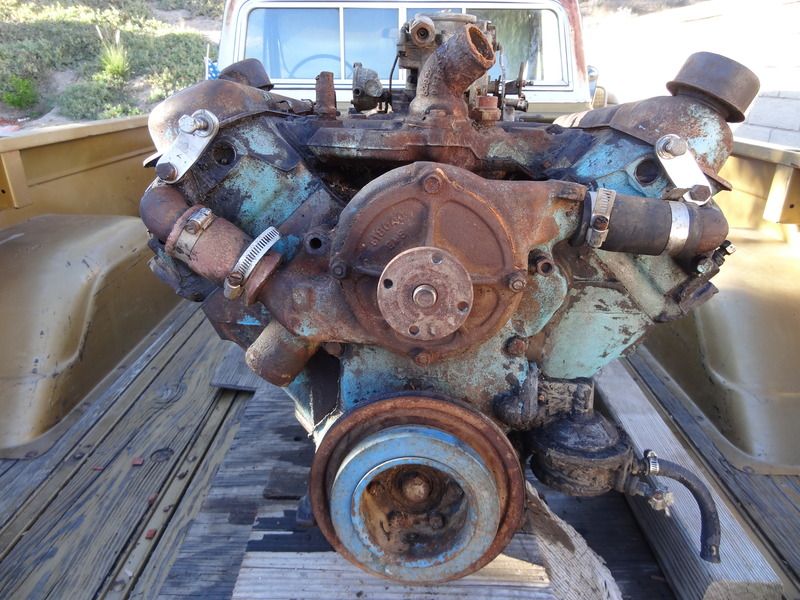 Block casting number 532000 is now visible. 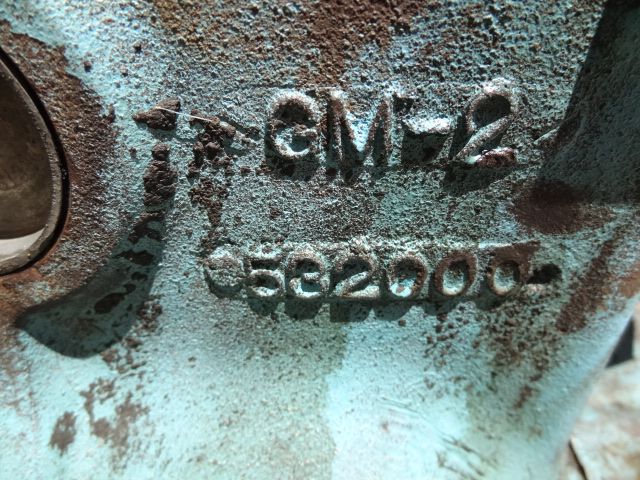 Cylinder head date codes are both the same, 'E 28 9'. 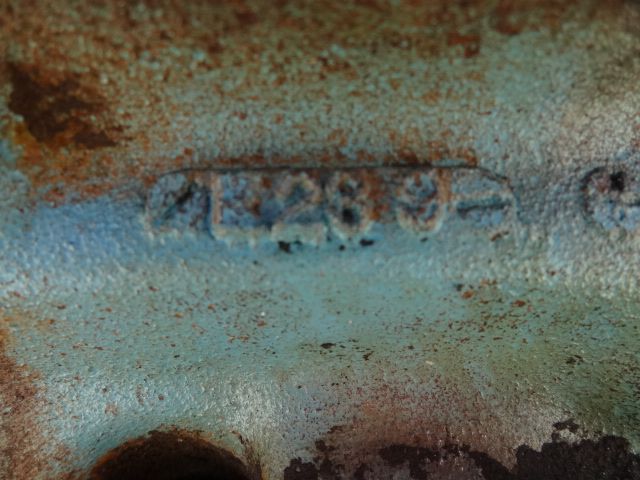 Cylinder head casting number 531395. 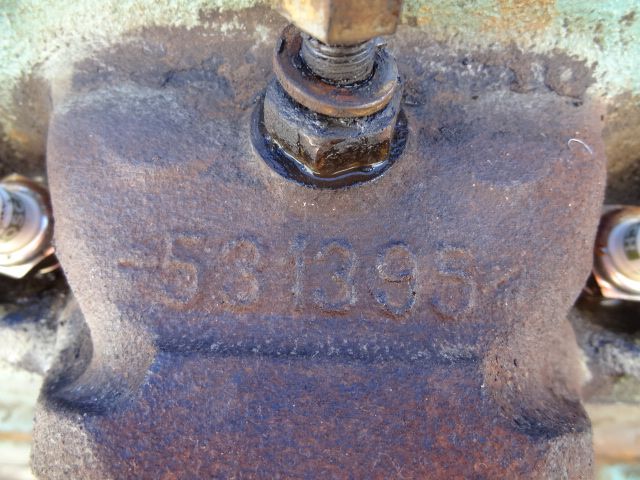 Timing cover casting number 532444. 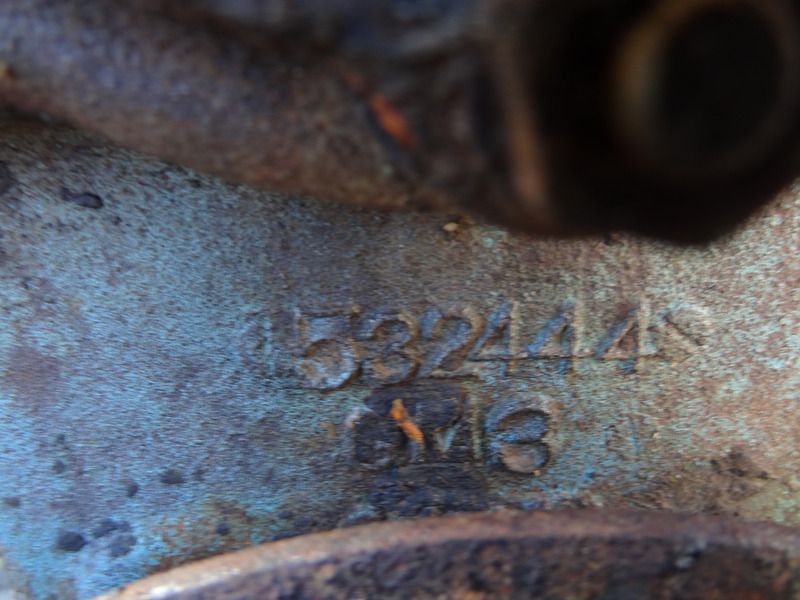 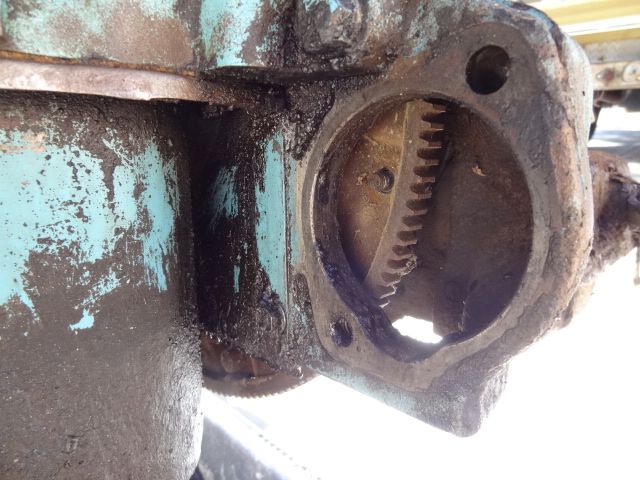
__________________
1964 Tempest Coupe LS3/4L70E/3.42 1964 Le Mans Convertible 421 HO/TH350/2.56 2002 WS6 Convertible LS1/4L60E/3.23 |
|
#33
|
||||
|
||||
|
Came out pretty clean for as dirty as it was before!
|
|
#34
|
||||
|
||||
|
.....for storage. I separated the engine from the trans by unbolting the aluminum trans bell from the iron bell housing attached to the block.
Raising the engine with my hoist was the easiest way to accomplish this, after pulling the trans back just enough to disengage the six torus studs from the flexplate.  I set the 389 on an engine dolly that I made from the bottom tray of a discarded shop cart and some tubing scraps. 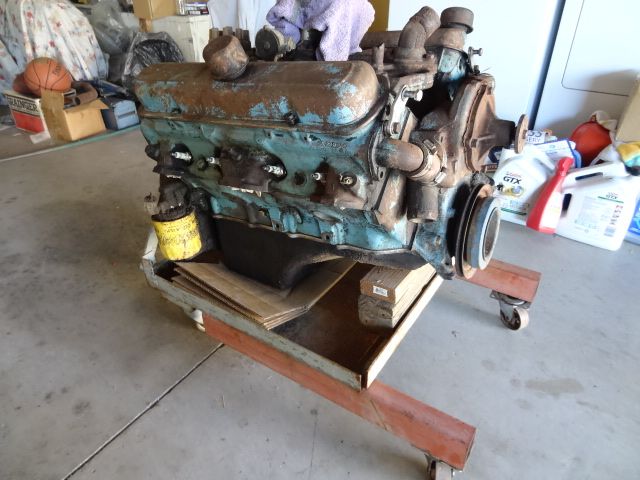 Now safely parked behind my freshly built '64 421 HO. 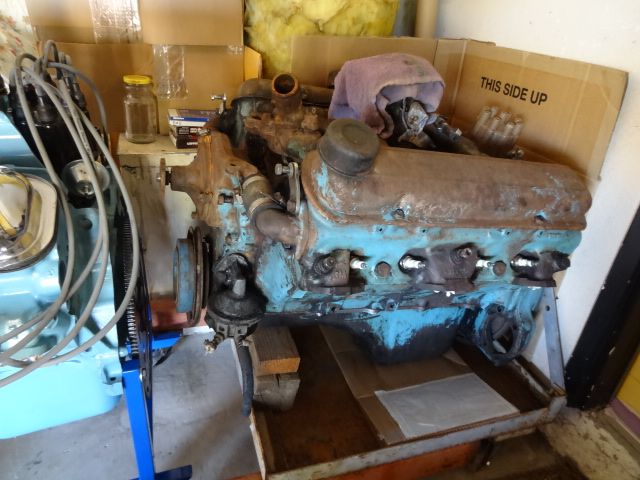 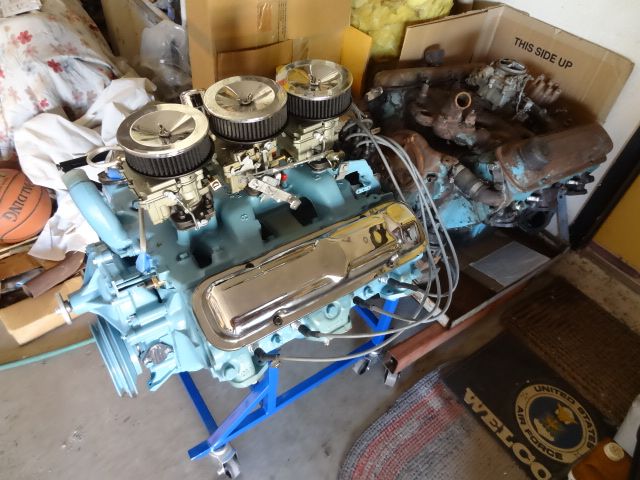 I hoisted the trans back into the bed of my truck for now, I'm not sure what I'll be doing with it just yet. 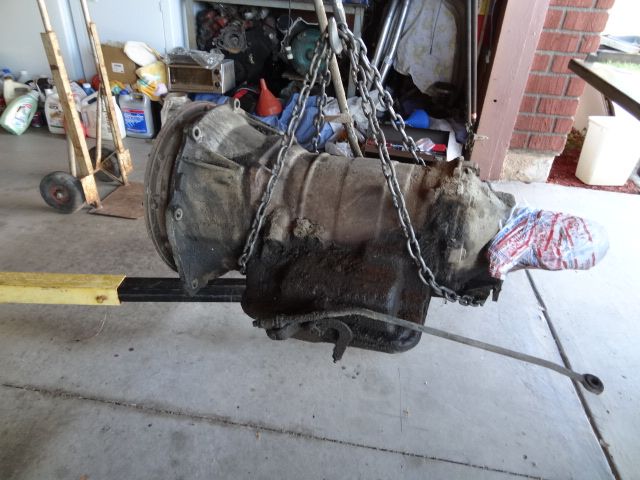
__________________
1964 Tempest Coupe LS3/4L70E/3.42 1964 Le Mans Convertible 421 HO/TH350/2.56 2002 WS6 Convertible LS1/4L60E/3.23 |
|
#35
|
||||
|
||||
|
.....to start assessing the condition of this old 389.
Pulled the valve covers and saw a fair amount of sludge buildup, pretty much what I expected to see on a 56 year old engine that had no PCV system for it's entire life. All in all not too bad nor too excessive, drivers side shown here. 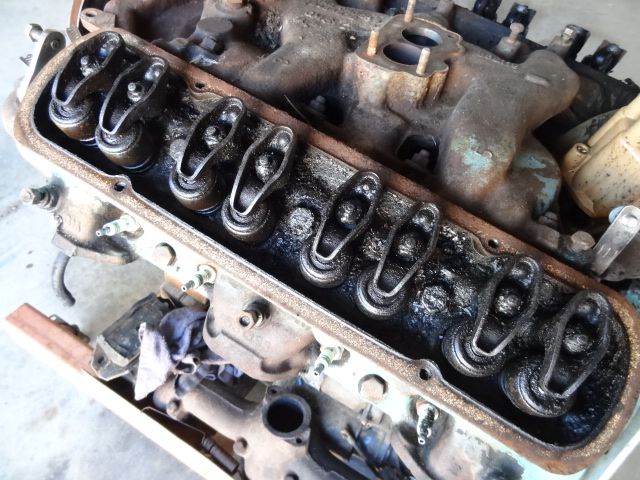 The passenger side clearly has some thicker sludge buildup compared to the other side. 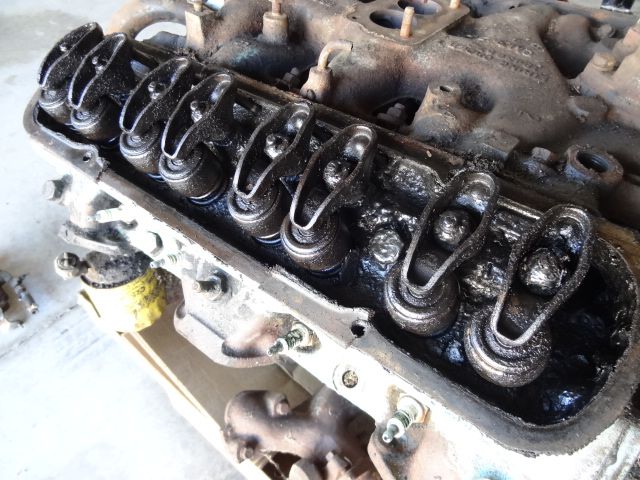 Someone must have removed the driver's side valve cover fairly recently during the engine's lifetime and cleaned out most of the sludge from the underside of the cover. 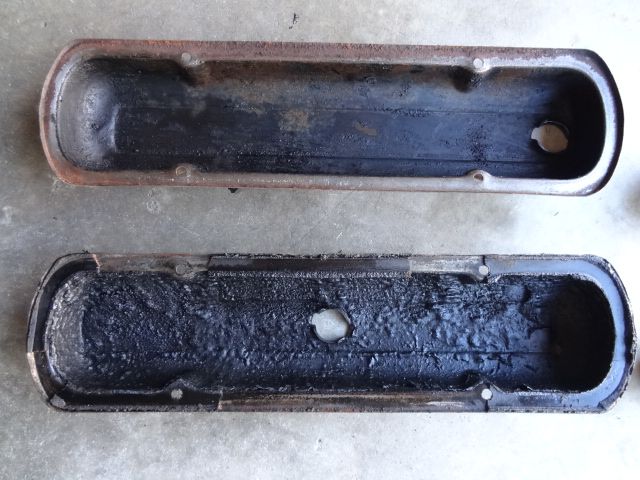 I had soaked both breather caps in Simple Green for about a week, they're now quite clean inside after a good rinsing. They were completely clogged with crud, obviously contributing to the sludge problem. The larger drivers side breather has horsehair inside, the passenger side looks to be filled with stainless steel wool. 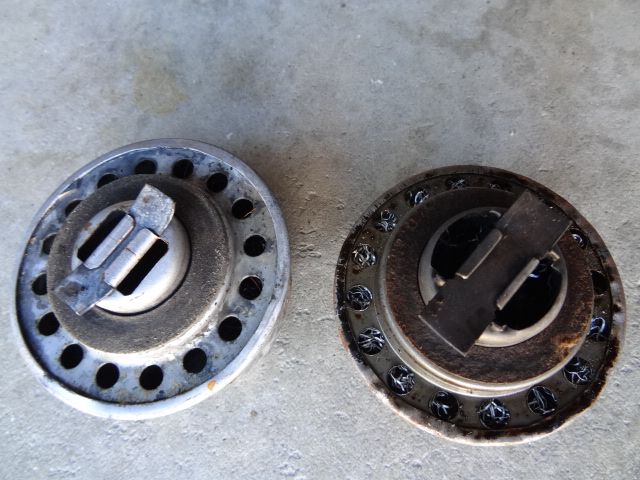 I removed the carb and saw that a small amount of water had made it into the intake manifold. Not enough that it ran down the intake runners and into any of the cylinders, just enough to leave a small rust puddle right under the throttle plates. 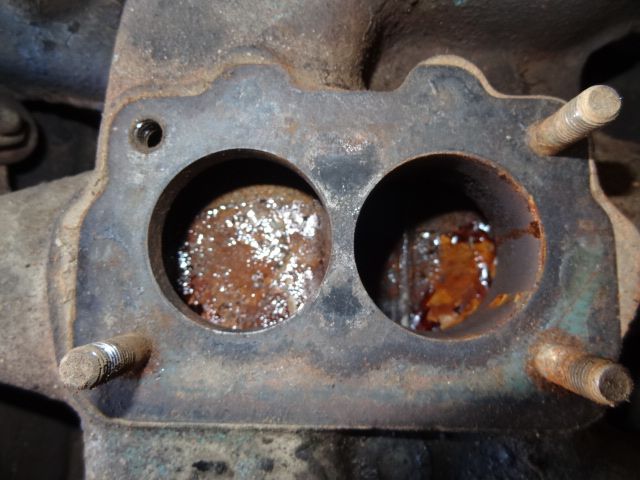 The topside of the throttle plates show some surface rust buildup from the water ingress, but nothing too excessive that won't clean up fairly easily. 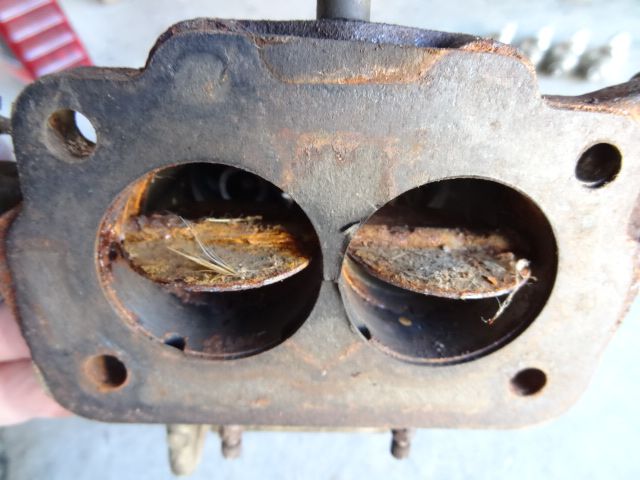 Bottom side of the throttle plates look pretty clean, looks like the carb had been recently gone through not long before the car went to salvage. 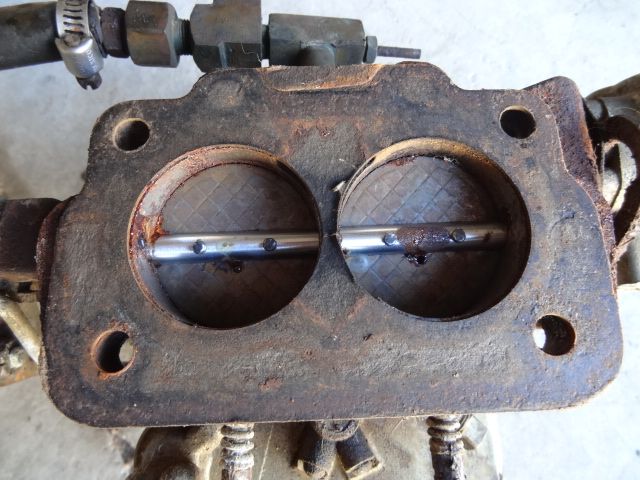 The carb is actually a 1964 unit from a 283 HP 389 with A/C and auto trans. Pretty much a perfect application matching replacement for the 280 HP 1958 A/C auto carb, only 5 years newer. 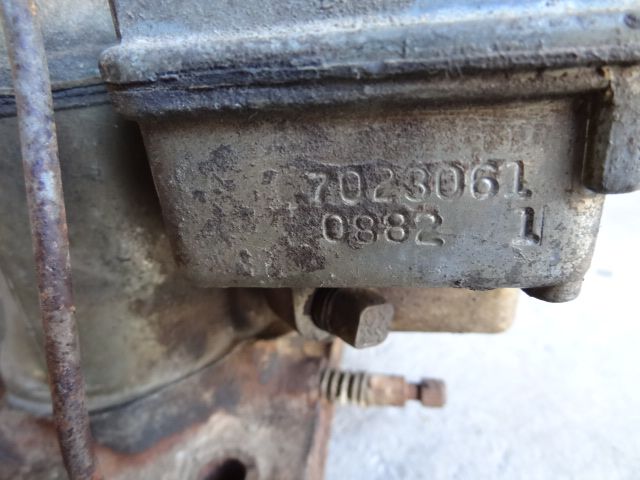 Spark plugs (Bosch WR9FC) must have recently been replaced, they look almost new. Cylinders look to be pretty healthy, but the fact that they were not run for very long doesn't really give me a true indication. Cylinders 1, 3, 5, 7. 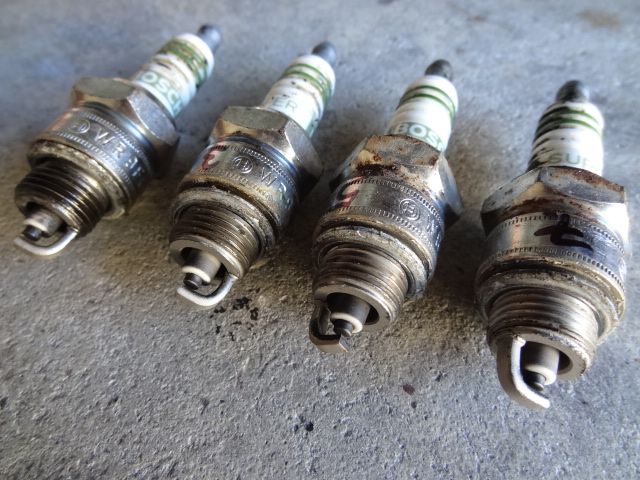 Cylinders 2, 4, 6, 8. 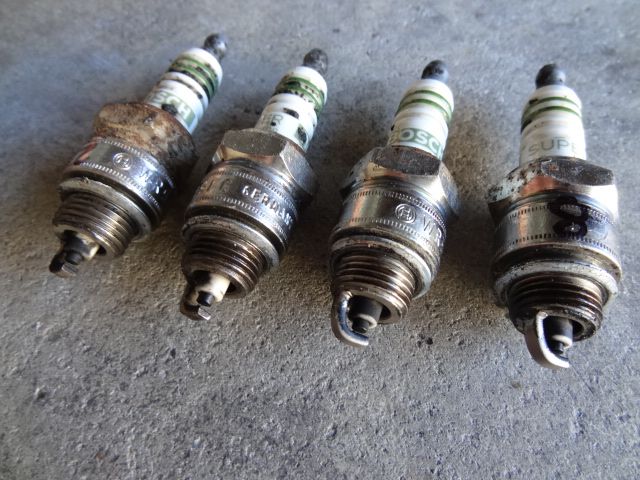 I'm going to lube up the cylinders and begin freeing up any sticking piston rings with a little dose of Marvel Mystery Oil. 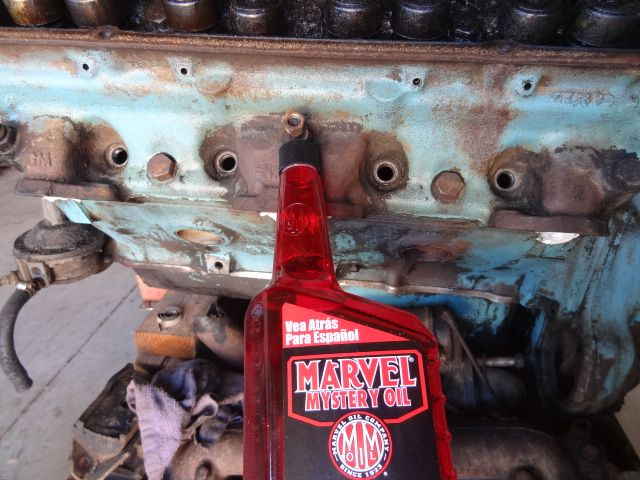 I used this 3oz oil bottle to squirt a little into each cylinder, trying my best to evenly distribute the contents of the bottle between all 8 cylinders. I'll do the same thing again in about a week to give it time to soak in. 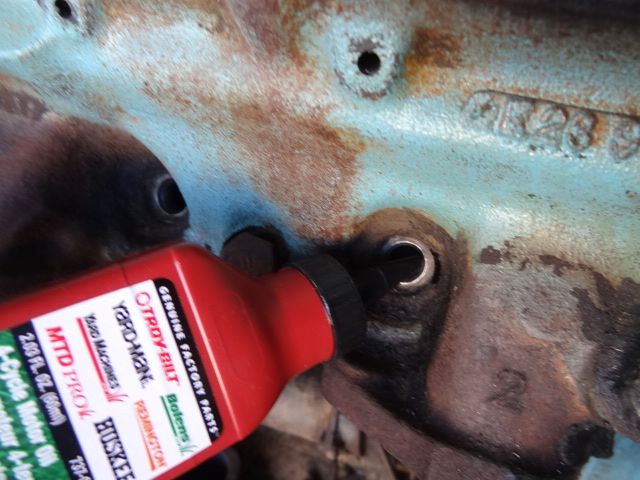 I lubed up all of the rocker balls and pushrod tips with some 10W-30 motor oil. Surprisingly enough, the distributor not only turned back and forth freely after loosening up the clamp, it popped right out after removing the clamp. No stuck distributor nightmare for me, needless to say I'm pretty happy about that!  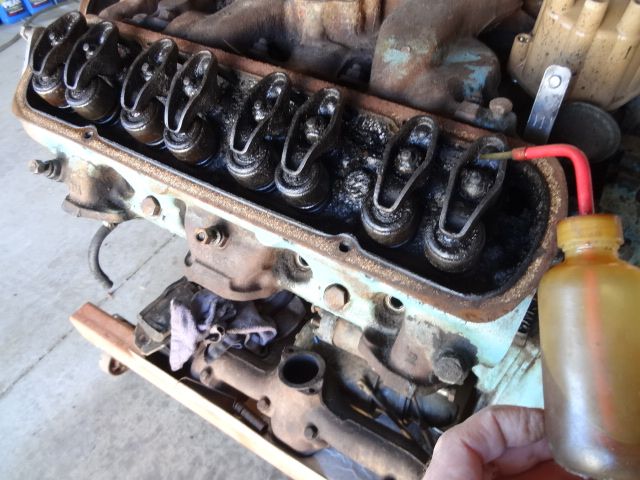 Overall the carb didn't look too bad, it just needed a good external cleaning.  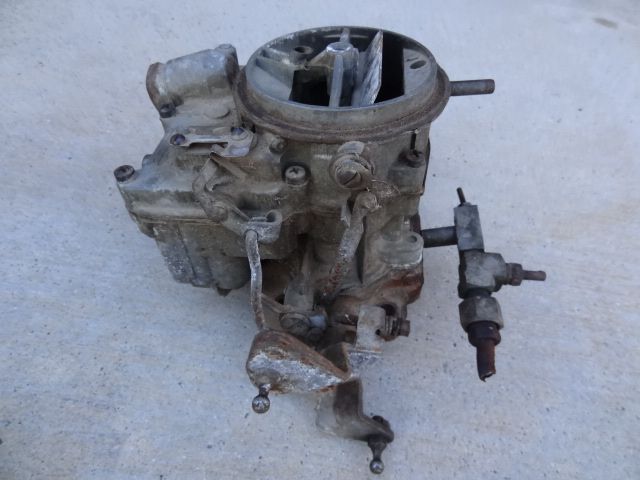 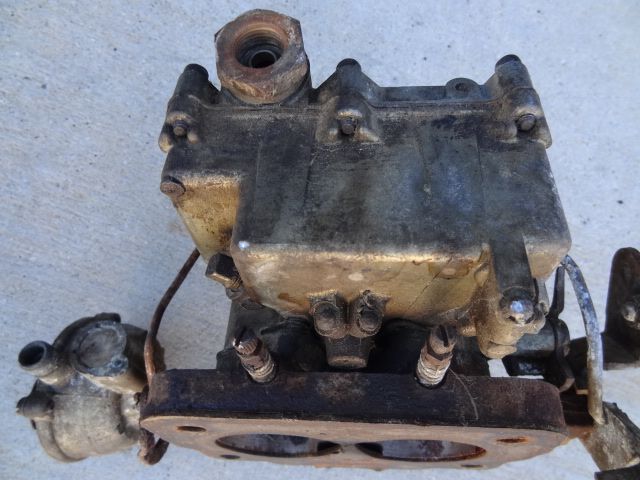 After about a half hour of going over it with a toothbrush and some Simple Green it came out looking pretty good. 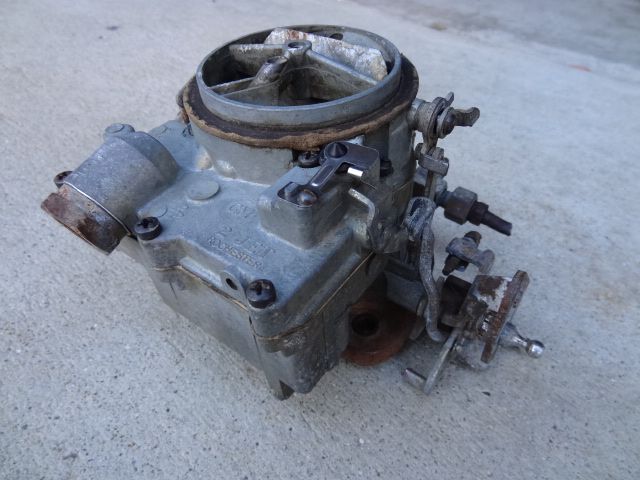 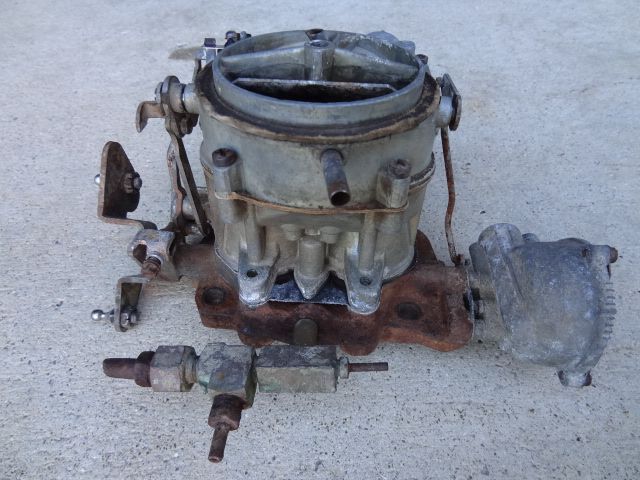 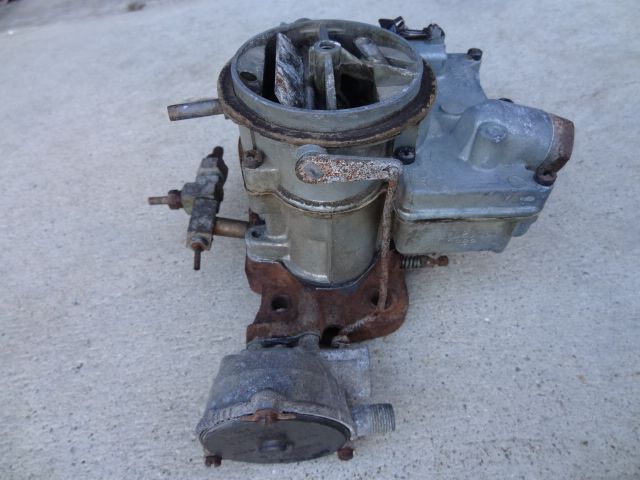  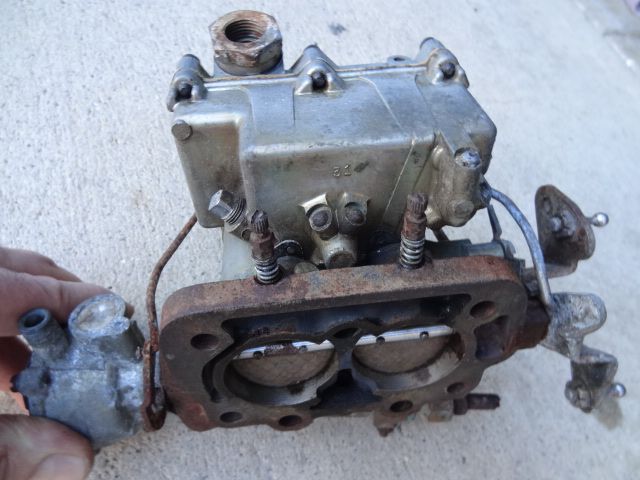 It took a little wire brushing to get most of the rust off of the top of the throttle plates. The way I see it, this carb's a runner now. 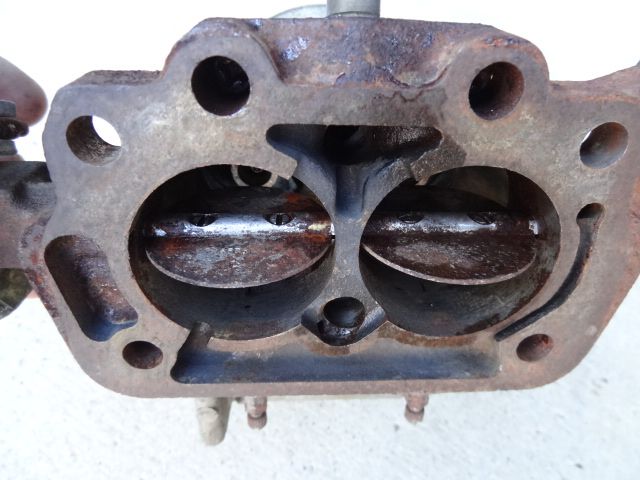 I did manage to pick up a cast iron 1960 stick shift bellhousing in good condition from a fellow PY member. In order to use a stronger modern stick trans you need to use a 1958 - 1960 bellhousing, any of the 1955 - 1957 bellhousings just won't do if you want to use a 'good' trans. Using a stick trans behind the early 389 eliminates the need for any kind of adapter. If you want to run a modern auto trans like a TH400 you would need to spend about $700 for an adapter from Wilcap. 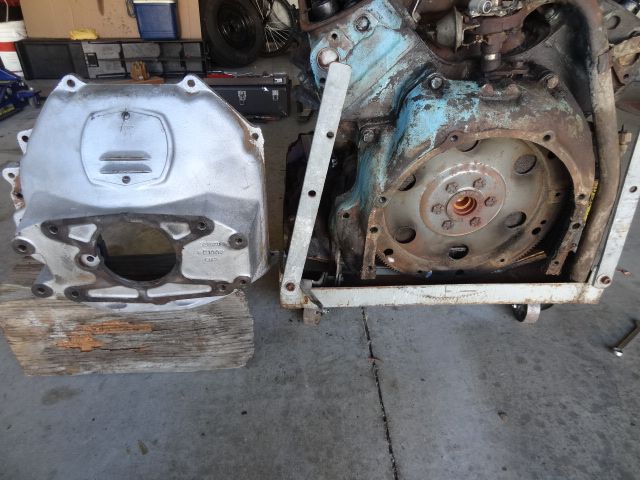 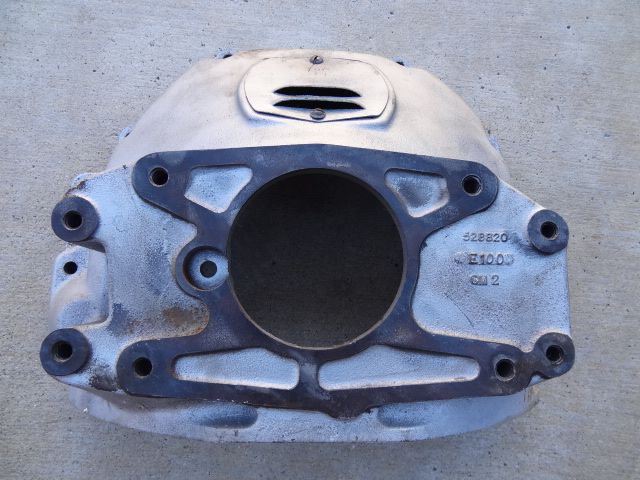 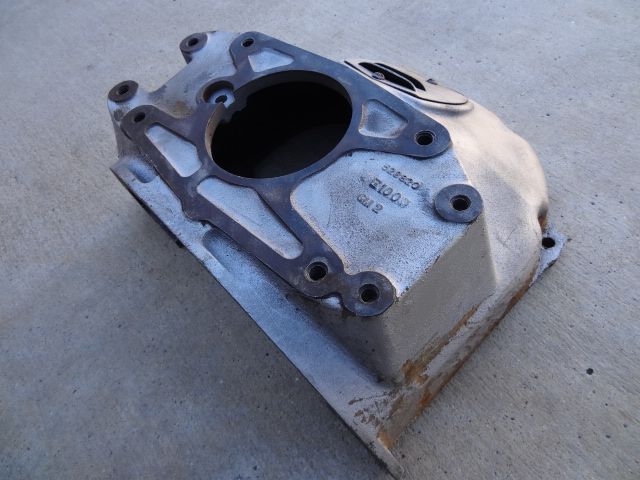 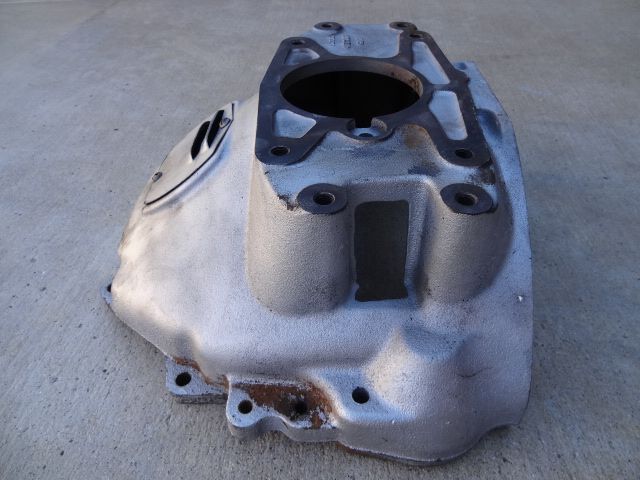 Here you can see where the starter mounts to the bellhousing, there's no way to bolt a starter to the 1959 block. Let me tell you, this sucker is heavy! 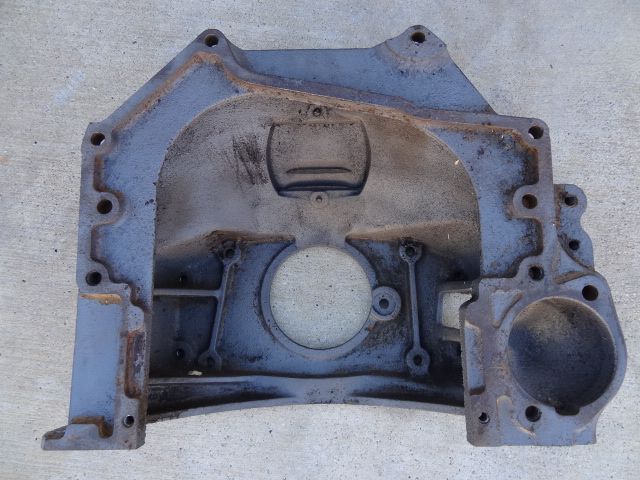 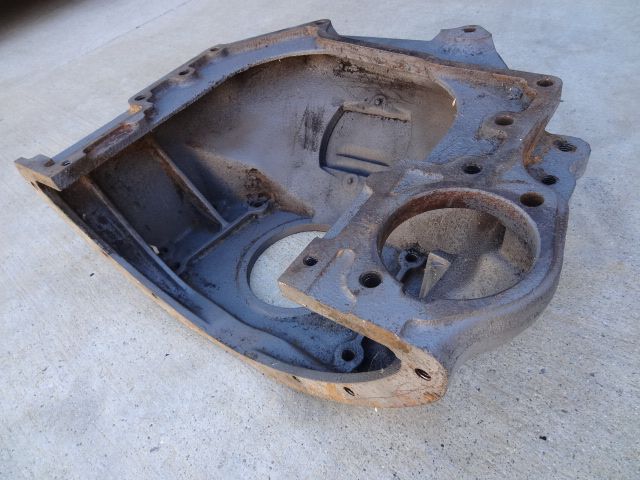
__________________
1964 Tempest Coupe LS3/4L70E/3.42 1964 Le Mans Convertible 421 HO/TH350/2.56 2002 WS6 Convertible LS1/4L60E/3.23 |
|
#36
|
|||
|
|||
|
She was listening. I was instructed to order this block. I love my wife...
__________________
It takes considerable knowledge just to realize the extent of your own ignorance. Dr. Thomas Sowell |
|
#37
|
||||
|
||||
|
.....so I can clean and reseal it. I also really need to clean out the valley pan that is surely packed with sludge before firing up this 389.
The factory 2-barrel intake takes the large base Rochester carb. To remove it you must pull it towards the passenger side to get it off of the 4 studs that retain it on the drivers side, rather than pull it straight up. 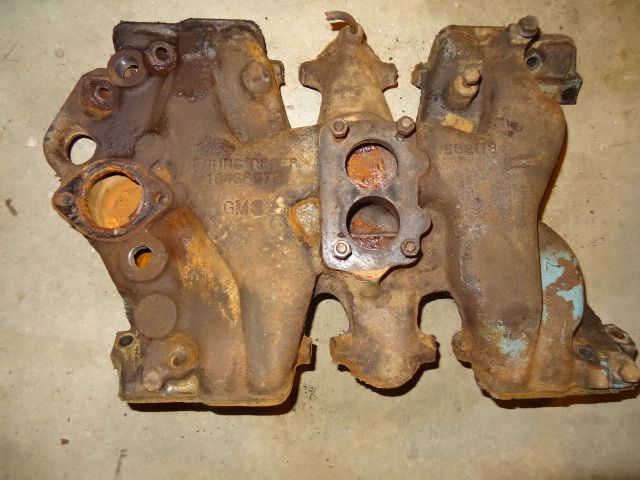  As expected there's plenty of rat droppings and debris sitting on top of the valley pan. 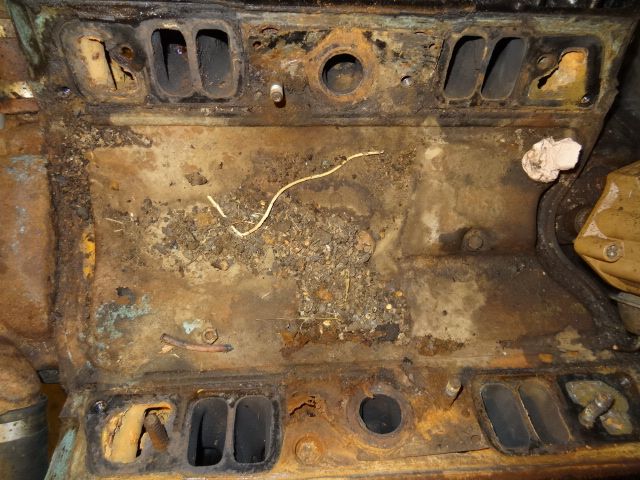 The intake ports look fairly clean with just a thin coating of black deposits. There may have been a vacuum leak from the look of some of the intake gaskets. Cylinders #2 and #4.  Cylinders #6 and #8.  Cylinders #3 and #1. 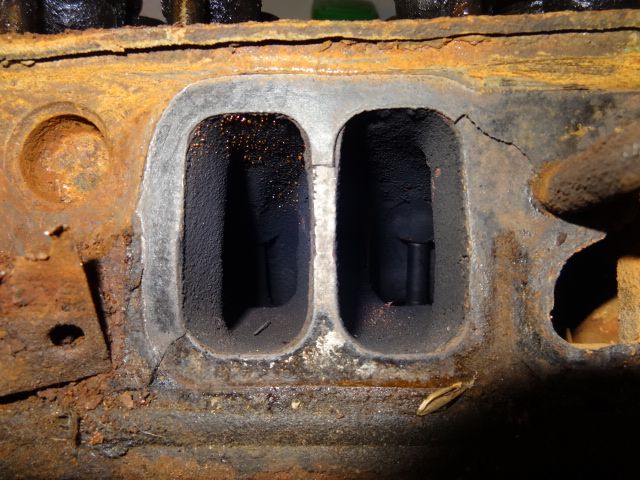 Cylinders #7 and #5.  A small amount of water did make it into the #2 intake port, but luckily enough the valve was closed so water didn't get into the cylinder. I'll close the valve and pour a little Marvel Mystery Oil into the port to clean it up a bit, a few flakes of rust should be easily digested without hurting anything. 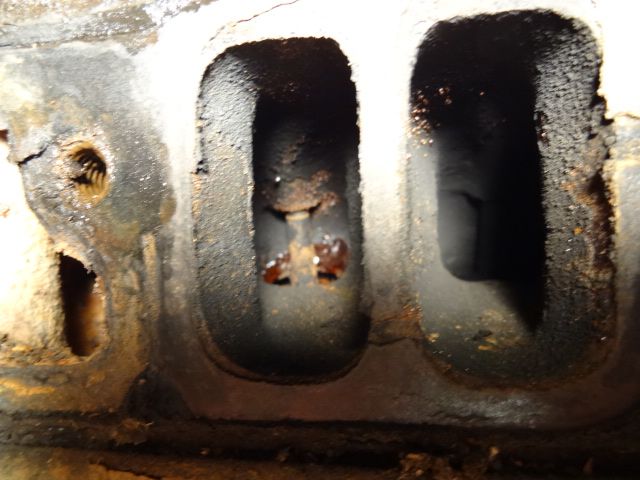 I stuffed the ports with paper towels to get ready for all the gasket scraping. 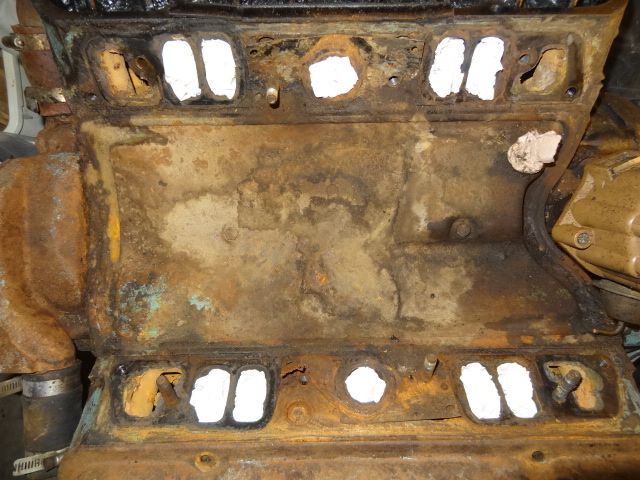 The exhaust crossover uses separate steel shim gaskets to seal it on each side, there's actually a formed lip stamped into the gasket that fits inside the port. 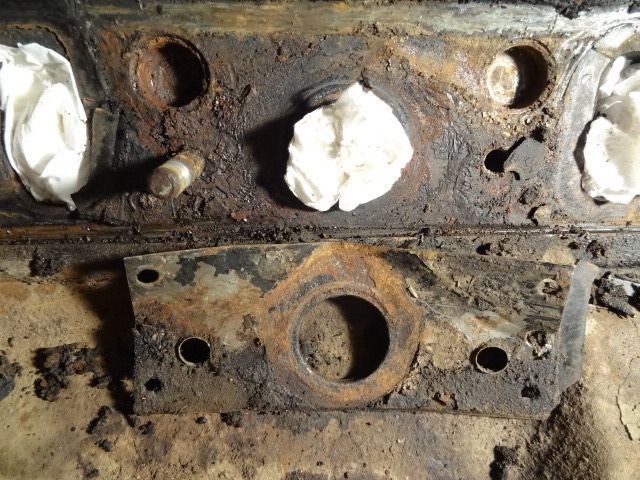 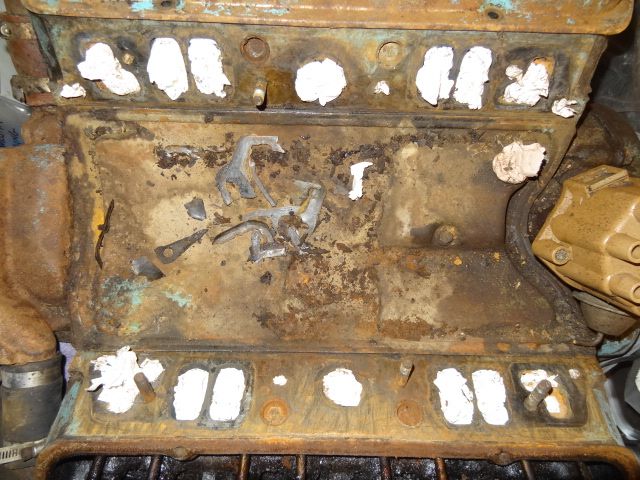 Scraped and wire brushed clean, pretty much ready to accept some new gaskets. I had to get these areas as clean as possible in order to minimize the amount of crud that will drop into the engine while removing the valley pan.  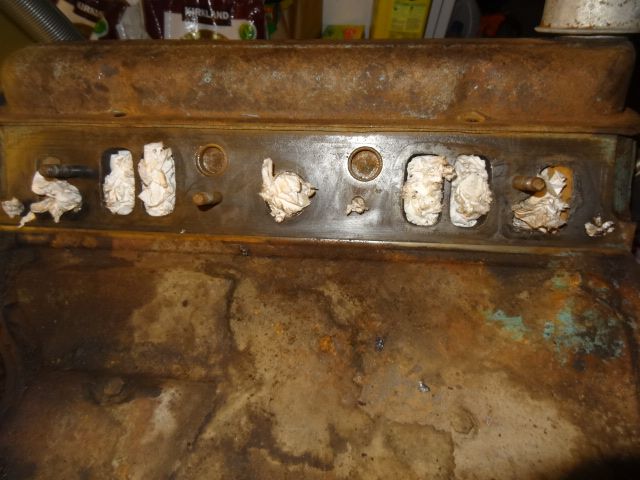 The sludge accumulation isn't too excessive for a 56 year old engine, however there were a few large flakes that had come loose from the underside of the valley pan resting in there. After many years of sitting the thin layer of sludge just dries out and flakes off. Now I can assess the condition of the cam and lifters, there's sure to be a couple of cam lobes that are going flat.  The valley pan will eventually come clean after a good long soaking in some cleaning solution. 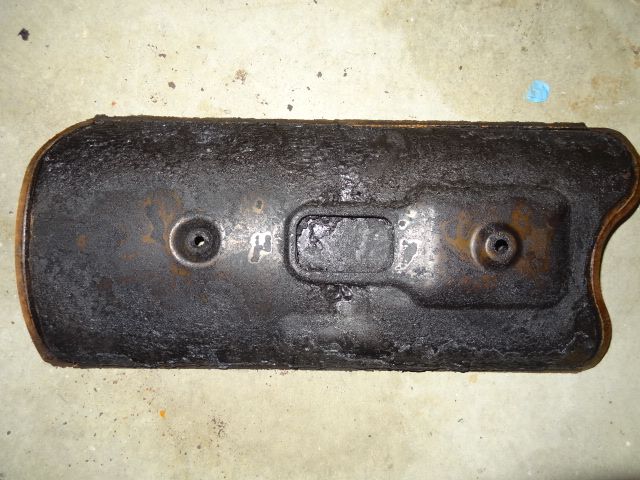 The top side will need to be bead blasted, after masking off the underside and any openings in the top side to keep the blasting media from getting inside. 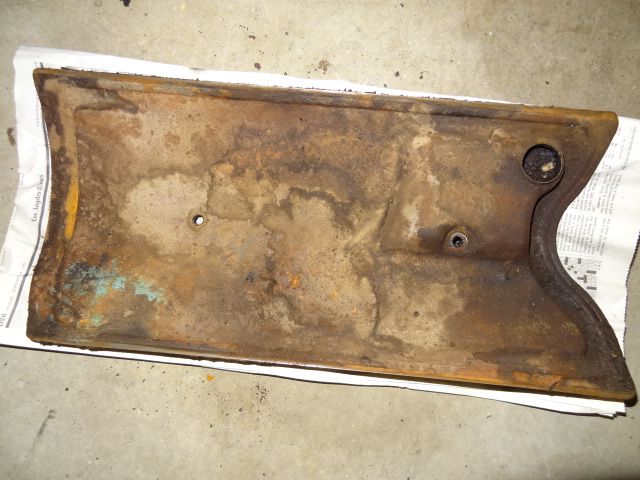 This opening is where the road draft tube connects, as you can see it's packed with crud. 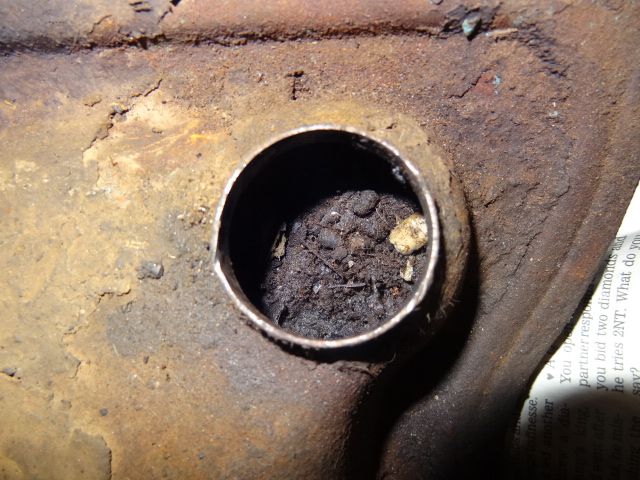 Putting the 389 to bed for the night. 
__________________
1964 Tempest Coupe LS3/4L70E/3.42 1964 Le Mans Convertible 421 HO/TH350/2.56 2002 WS6 Convertible LS1/4L60E/3.23 |
|
#38
|
||||
|
||||
|
If you want to run a modern autobox there is a thread in the race section with a guy in Aussieland who has the drawings for the early block to late trans swap, it's basically a laser cut 1/4" steel adapter plate with provision for mounting the starter to it.
I used a '59 389 block in my turbo race combo and adapted a TH400 to fit using the midplate. The block is a good foundation for a race engine, my sonic testing showed .250" of metal on virtually all the bore walls. I threw all the rest of the parts in the scrap though! |
|
#39
|
||||
|
||||
|
After a few good long soakings and several rinsing sessions the valley pan came out pretty clean, probably 95% of the accumulated crud was cleaned out of it.
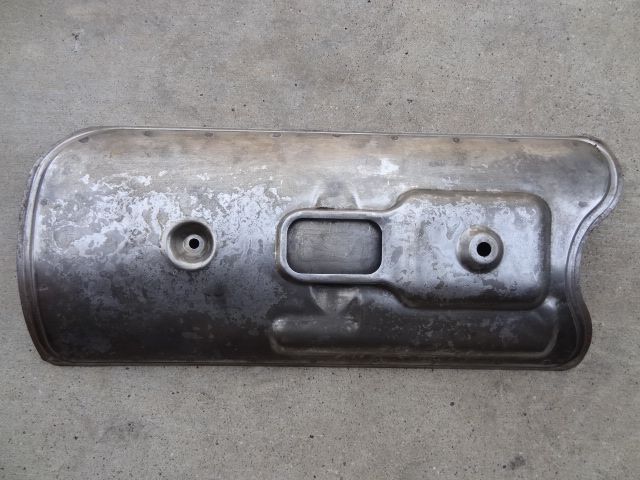 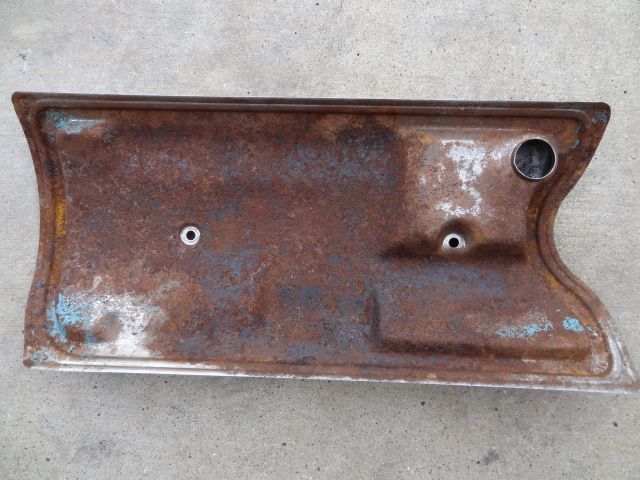 Going to put the intake back on so I can use my lifting plate to put it on the engine stand. I want to remove the oil pan to clean it out and check on the condition of the bottom end. First the valley pan.  Now the intake. 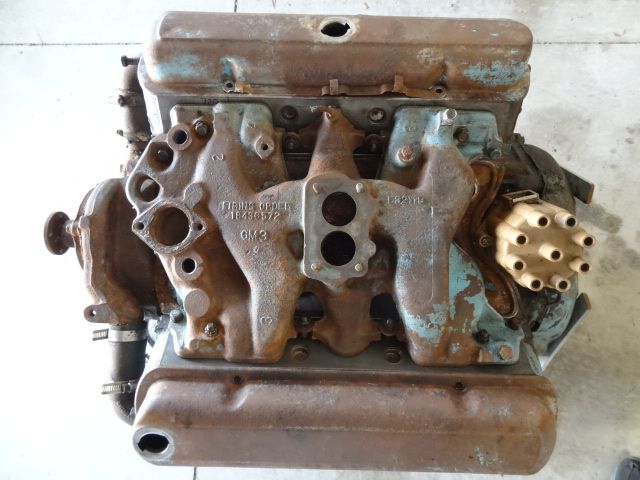 Lifting plate installed, ready for the engine hoist. 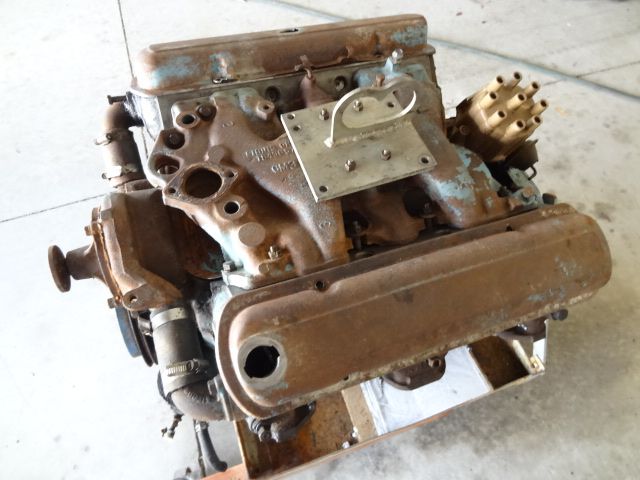 Warming up the sump a bit with a heat gun to help the cold oil drain a little better. 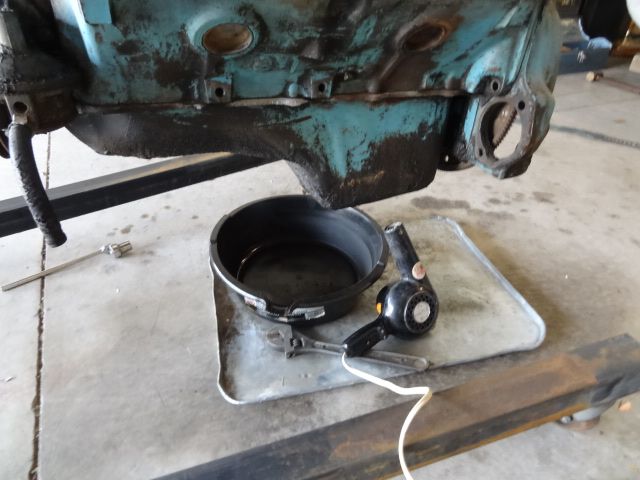 Dirty old oil - it looked like 4 or 5 quarts drained out, a good sign.  Pulled off the auto trans flex plate and bellhousing. A bit of a strange arrangement compared to the later Pontiac design, first you must remove the flex plate and drop it straight down out of the bellhousing. Next there is a rear sheet metal shield that attaches to the bellhousing with two bolts as well as the two rearmost oil pan bolts, the shield also serves to support the rear oil pan sealing area. After all that you can finally remove the cast iron bellhousing. 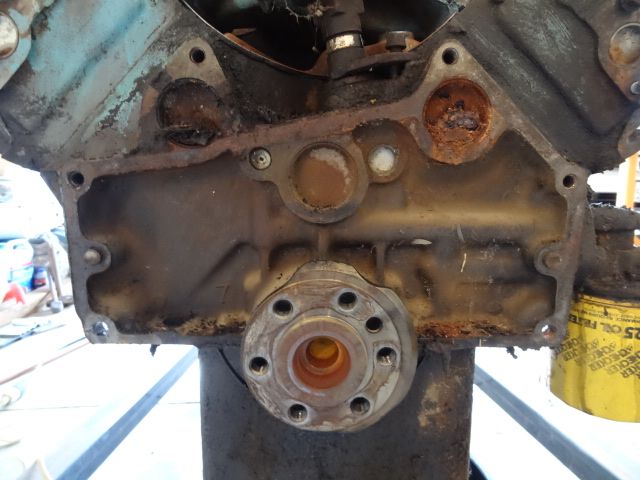 Up on the engine stand, ready for oil pan removal as soon as I get some time. 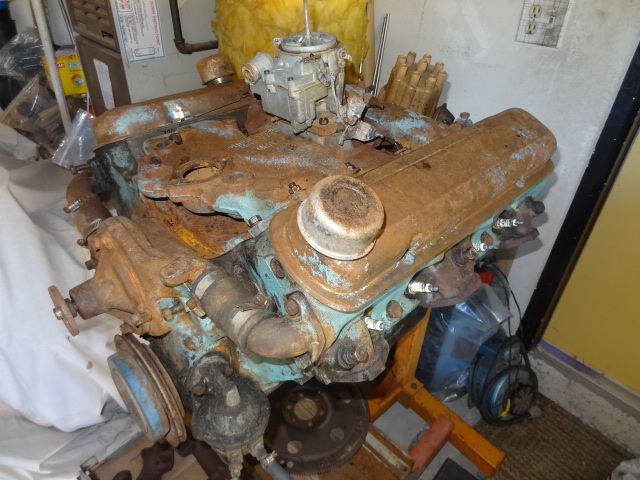 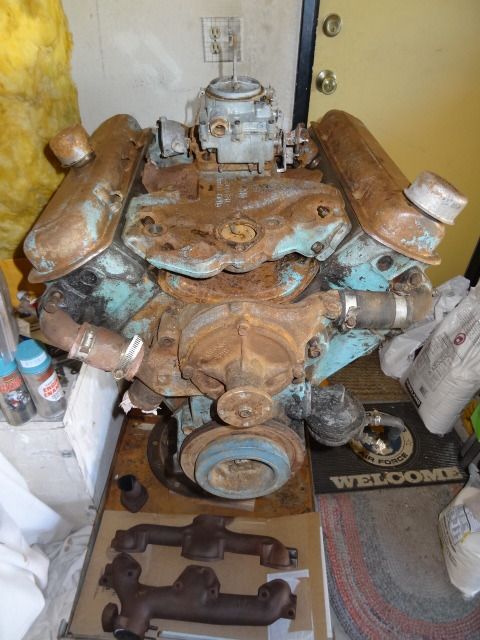
__________________
1964 Tempest Coupe LS3/4L70E/3.42 1964 Le Mans Convertible 421 HO/TH350/2.56 2002 WS6 Convertible LS1/4L60E/3.23 |
|
#40
|
||||
|
||||
|
Here's a closer look at some of the unusual features of the casting # 531395 1959 heads, all 1959 engines used this head casting.
Valve sizes are 1.88" intake and 1.60" exhaust. 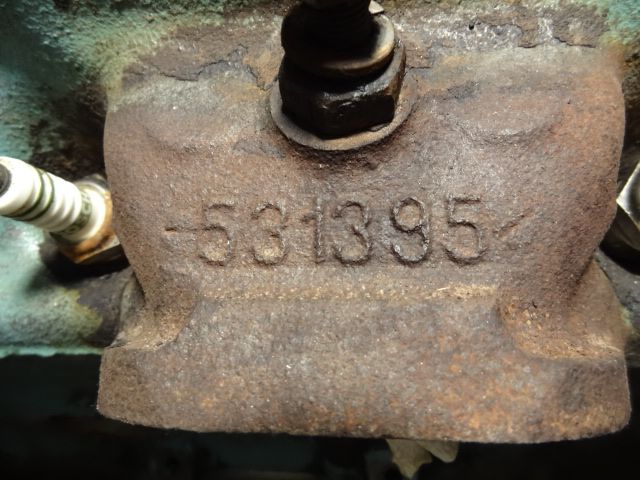 The intake and exhaust crossover port placement is exactly the same as the 1961 - 1964 heads. The bolt pattern is identical as well. 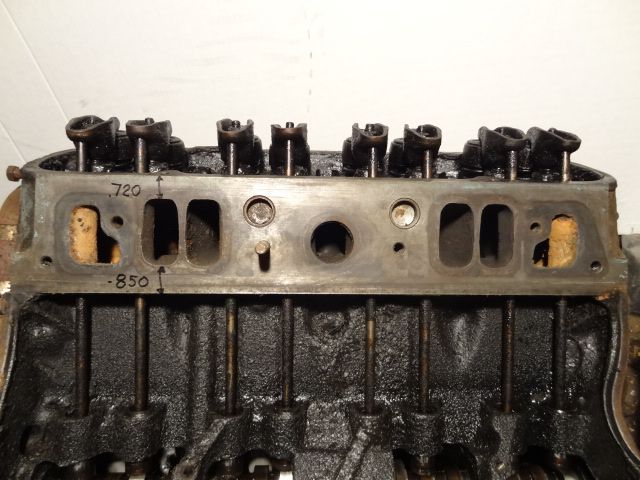 For the sake of intake and crossover port comparison, a 1964 9770716 389 head is pictured at the top, a 1970 #13 400 head below. Port entrance size is nearly identical between the two heads, 2.050" X 1.110" for 1964 and 2.070 X 1.100" in 1970.  Here is a 1964 intake gasket laid over the 1959 head. As you can see the water ports are in a completely different location.  Here's the 1959 intake manifold. 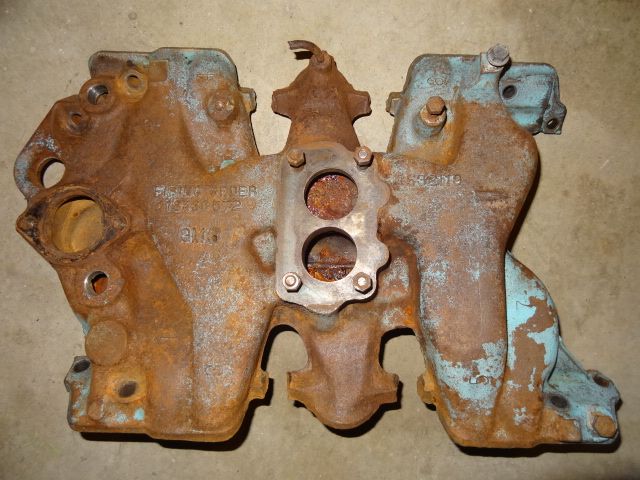 There isn't much material cast into it in the exhaust crossover region, it uses studs, castle nuts and large thick flat washers to clamp down on and seal the ports in this area. It doesn't use a thermostat bypass port to the timing cover. 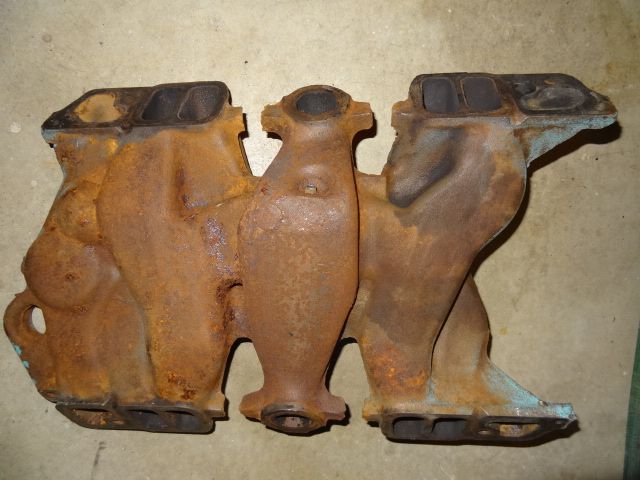 1964 intake, showing a lot of added material around the exhaust crossover flanges and different water port placement. 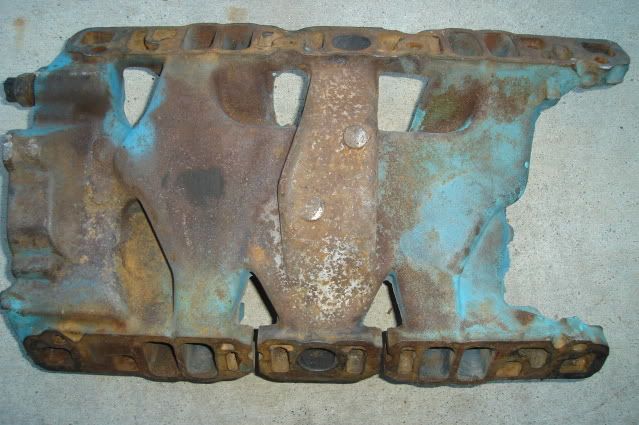  Here is where we will see one huge difference between the 1959 (1955 - 1960) and the '61 - '64 heads. The intake ports are almost the same exact size as the '64 head at 2.050" X 1.100", but the cylinder head itself is .320" taller than the later heads. The valve cover rail is higher, both cylinder heads have the same .850" measurement from the cylinder head deck to the bottom of the port. However the '59 head measures .720" above the port compared to only .400" for the '64 head. 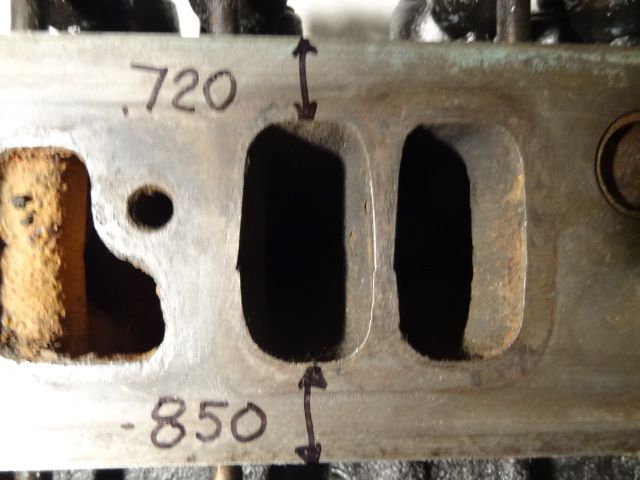 Note that since the valve cover rail is so much higher on the '59 head it doesn't have the small bump cast into the roof of 2 of the ports to keep the valve cover bolt hole from breaking into the port roof like on the '64 head. Also take note that there are no openings on the intake side of the head that lead to the crankcase like on the later heads. 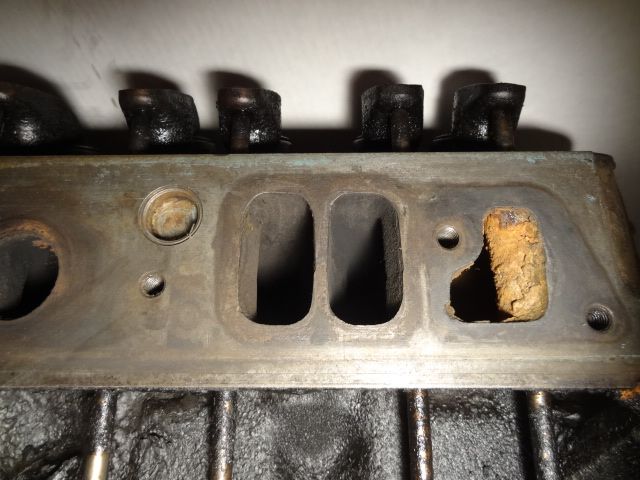 Again for comparison here's the round casting protrusion in the roof of the two end intake ports on the '64 head, put there to seal off the bottom of the tapped holes for the valve cover bolts. 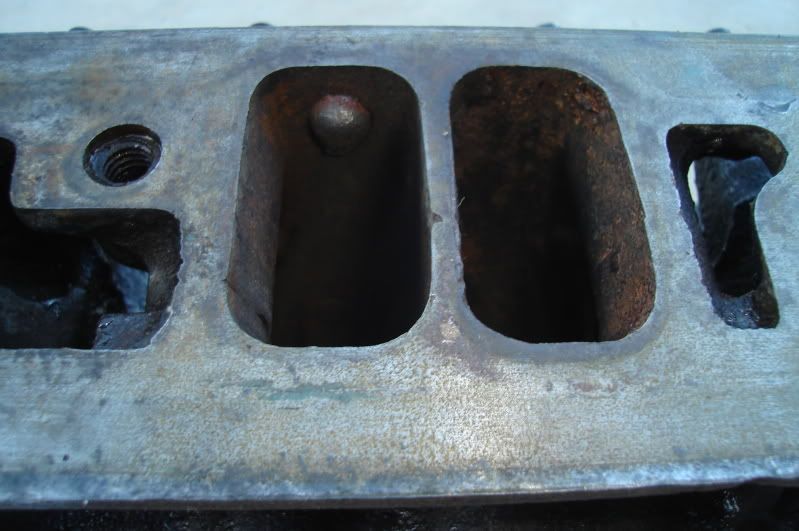 Another unusual feature that likely was the main reason the heads were so much taller, are the 4 intake valve guide vent holes in the side of the head just below the valve cover rail. These were put there to provide a vacuum break for the valve guides, to prevent them from sucking oil down into the combustion chambers. These tall heads must have made these early engines look just a little bigger and wider than their later cousins. 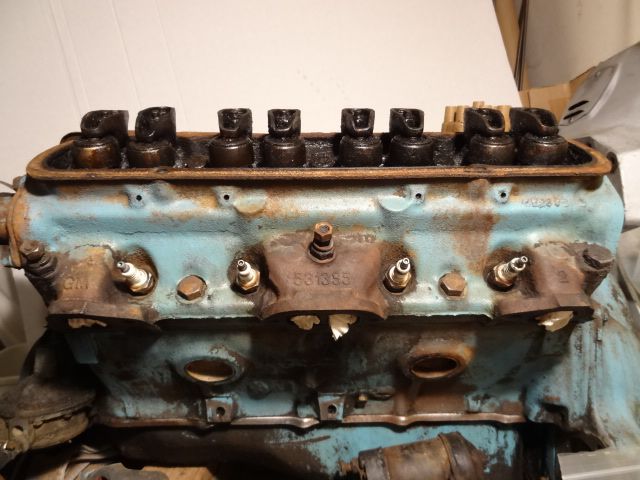 Vent hole diagram from the factory manual. 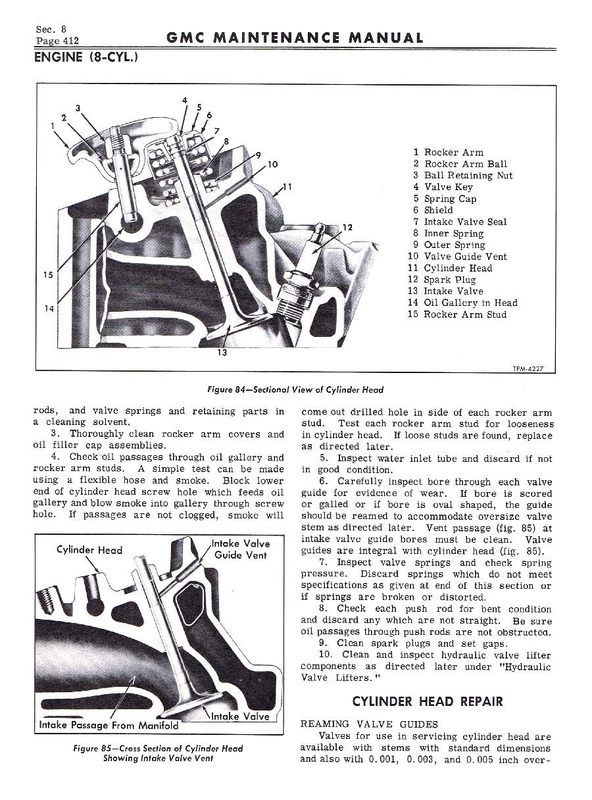 A closer look at the vent holes. 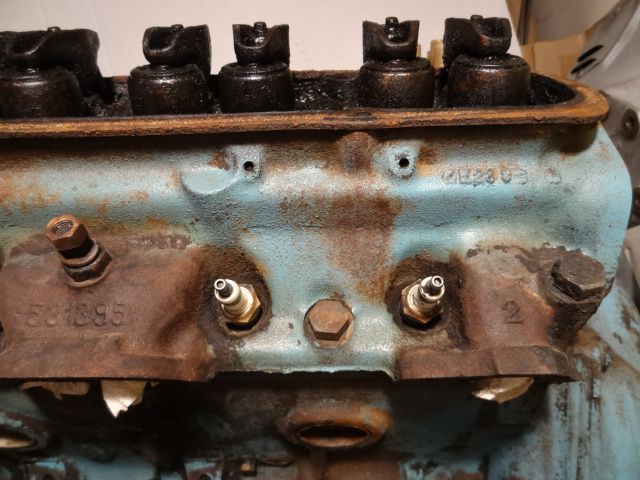 1959 was the last year that Pontiac used reverse cooling, pumping water first through the front of the cylinder heads and then down through the block. Here is one of the water fittings on the front of the head. 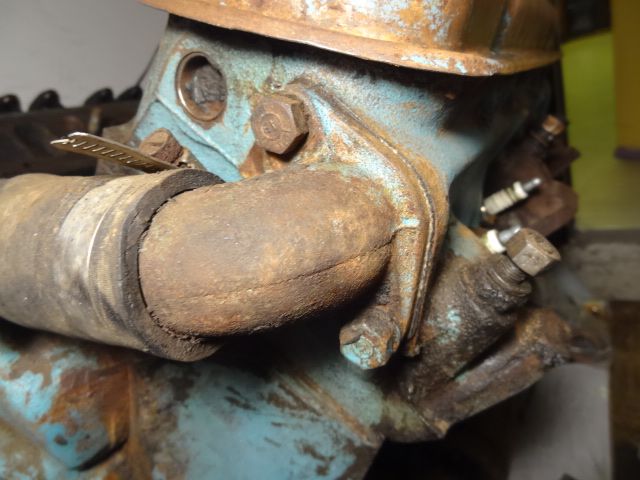 A view of the rear of the head, better showing the placement of the water channel. The small soft plug above the water channel blocks off the ends of the oil passage cast into the head that feeds oil to the rocker studs. All Pontiac heads oiled the rockers through the rocker studs until the introduction of the '63 -'64 9770716 heads, the only exception being the early Super Duty heads. 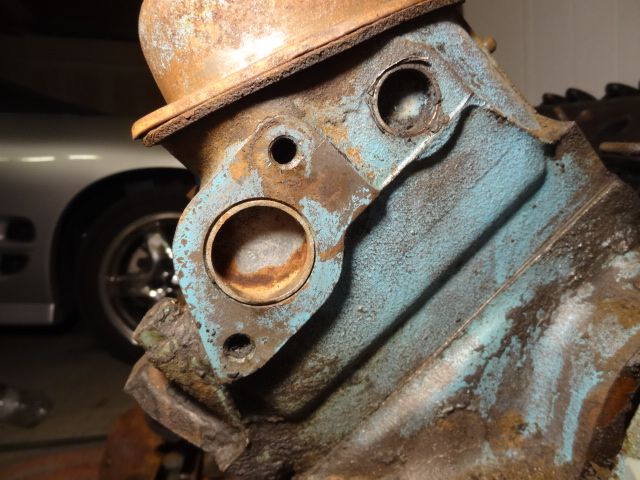
__________________
1964 Tempest Coupe LS3/4L70E/3.42 1964 Le Mans Convertible 421 HO/TH350/2.56 2002 WS6 Convertible LS1/4L60E/3.23 |
| Reply |
|
|